The best events at London Design Festival and London Craft Week, art postcards, takeaway packaging you’ll want to keep, a new hero for children and everything you need for camping – including a kitchen sink
Designed for life – festival highlights

London Design Festival was one of the first design events post-lockdown to commit to running on its scheduled September dates. The festival programme reflects the events of 2020. This year there’s a new Virtual Design Destination by Adorno hosting work by European designers unable to travel to the UK. The exhibition theme is The New Reality and all the work has been inspired by, or created in response to, the pandemic.
One LDF landmark project is the Hothouse, a greenhouse created by architects Studio Weave and planted by gardener Tom Massey. The exotic jungle within features tropical plants that will be able to be grow in the UK climate by 2050 if global warming and the climate crisis continues. There will also be a series of talks and seminars in association with the Ellen MacArthur Foundation to start a long-term project looking at the circular economy and to show that a sustainable future starts with design. Tom Dixon is hosting a Guardian Live Events talk on the future of dance floors in the new socially distanced age. Connected is a collaboration between Benchmark furniture, the American Hardwood Export Council and nine designers, including Thomas Heatherwick, Ini Archibong and Jaime Hayon. The aim is to create furniture for working from home and to look at how these designers adapted their working practise during lockdown. The creative industries have never felt more relevant.
London Design Festival runs 12-20 September
Swatch but without the plastic

The new Bio-reloaded 1983 collection from Swatch is both futuristic and retro. While the styles echo the watch designs from the first few collections from Swatch after the Swiss company launched in 1983, they’re made from extremely modern materials. All plastic has been replaced by a material extracted from castor plant seeds. The watch case has also been switched to biodegradable packaging made from potato and tapioca starch. Swatch was one of the first fashion watch brands to become a sensation – let’s hope others jump on this trend too.
Meet a beautiful new picture-book hero
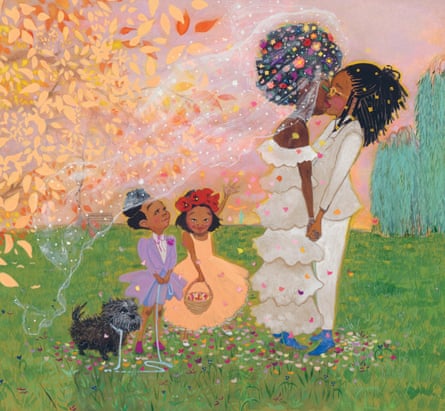
When American author Jessica Love won the Klaus Flugge Prize for the most promising newcomer to picture book illustration last year, former British children’s laureate Anthony Browne described her work as “astonishingly beautiful”. It’s hard to think of better words for Julián is a Mermaid, her book about a boy who wants to be a mermaid and his nana Abuela’s unconditional acceptance and support for her grandchild. The award-winning book with its gouache on brown paper illustrations became a must-read for any family who want to discuss LGBTQ issues or encourage children to express themselves. Looking at the beautifully observed scenes of city life and the excitement of New York’s annual Mermaid Parade in its pages is a delight in itself.
Love says one of the best responses to Julián was from kindergarten teacher Vera Ahiyya. “She was the first teacher to ask me to do a school visit. At the end of the school year, her class gifted her a tattoo of Julián – who now swims on her arm! I am still levitating from the coolness of that. You can see it on her Instagram which is also full of excellent, diverse reading recommendations.”
This month brings the publication of sequel Julián At The Wedding, where Julián and Abuela celebrate two brides at their “party of love” and meet a new friend, Marisol. Just as with the Mermaid Parade in her previous book, the wedding scenes let Love’s skill as an illustrator run wild.
“Costuming is my favourite,” she admits. “I was actually planning my own wedding while I was making that book, but we had to cancel it due to Covid. I put my fiancé and myself in the illustration of everybody dancing at the end, so I got to be in a wedding anyway. Almost everybody in that scene is someone who has been important to me and to Julián (Vera is there, so are my grandparents). I tried to make sure everyone had a costume they would dig.”
Love’s skill for capturing the joy of life in a tale that, once again, celebrates self-expression will cement her reputation as a storytelling talent – and Julián as a hero for little kids everywhere.
Julián At The Wedding by Jessica Love (Walker Books) is published 1 October
Maps and signs for modern times

As social distancing guidelines continue to be as clear as mud, one company has your back. Applied is a London studio of urban planners and graphic designers dedicated to producing comprehensive maps and signposts. Covid has created the need for a completely new set of guidelines for public safety, guidelines for which there are currently no universal pictorial language.
“The situation is unusual because social distancing measures are counter to our habits,” says Tim Fendley, founder and creative director of Applied. “Clear messages at the right moment have a big impact. It’s better everyone is effective in reducing transmission, while they go about their business freely, than go into further lockdowns.”
So this month, Applied has made its toolkit library of infographics available to download for free. All signs are created in response to Covid social distancing guidelines for use in any public area. “If you remind people what is expected of them and how to behave,” says Fendley, “ then we have a chance to influence healthier behaviour that helps everyone.”
Celebrating craft with workshops and shows
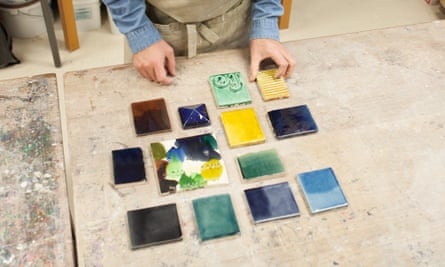
Creative investor Guy Salter launched London Craft Week in 2015 because “there wasn’t a moment for making. I wanted a platform that puts all sorts of creative talent on the map.”
This year’s programme includes exhibitions, demonstrations and workshops from famous names, as well as independent makers. London’s food and drink community feature prominently with Fortnum & Mason’s, Sipsmiths and Paxton & Whitfield keeping the weavers and whittlers fed and watered. LCW highlights include Create Day – an ambitious digital programme documenting 24 hours in the world of craft, with makers livestreaming their work; The Natural Room, which is a curated show of designers who use materials such as willow and clay; and 300 Objects, a show of emerging and established craftspeople, curated by a panel including designer Yinka Ilori and art collector Russell Tovey. Emma Love
London Craft Week runs from 30 September-10 October
Bright young thing of the art world
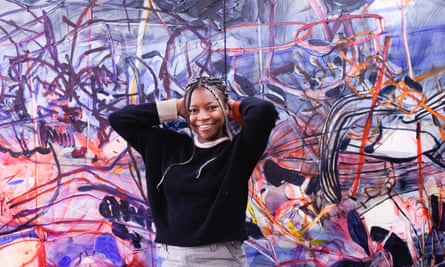
Jadé Fadojutimi’s dynamic, colourful canvases buzz with life. It’s not hard to see how she caught the eye of gallerist Pippy Houldsworth at her Royal College of Art degree show in 2017, or why her work – a mingle of abstract with glimpses of figures – has marked her out as one of the young British artists to watch. She’s had a show at Gisela Capitain in Cologne and next year will have one at Miami ICA where some of her work already hangs. At 27, she’s currently the youngest artist to have work in the Tate collection. “It wasn’t news I was expecting or necessarily hoping for,” says Fadojutimi of the Tate, “but I appreciate it. Things keep happening before I have time to dream about them.”
See her work first hand this month in a new show, Jesture, at Pippy Houldsworth. The pieces were created during lockdown while Fadojutimi worked from home, rather than her studio. Although her art continues to explore themes of identity and her sense of self against the sweeping abstract landscapes that fill her canvases, the new works have subtle differences. They are oil pastel rather than her usual paint, while knotty swirls take the place of the abstract strokes.
Fadojutimi will also appear in the Liverpool Biennale from March 2021. The 11th edition of the UK’s largest art festival is titled The Stomach and The Port and explores notions of the body. Fadojutimi’s eye for colour is extraordinary. “I define the majority of life through colour,” she says, “and painting is a way for me also to understand my way of seeing.”
Jesture is at the Pippy Houldsworth Gallery from 16 September to 31 October
Food for thought
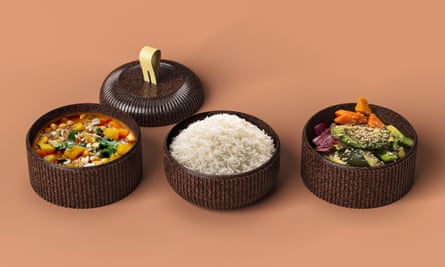
One business thriving in the Covid age is takeaway food. In 2019, the food delivery market was worth more than $53bn a year globally – and this year UK takeaway sales were 20% higher, according to the British Retail Consortium. While sales are good news for any industry, takeaway packaging can leave a nasty taste. Much of it is bad for the environment – and also bad for the morale of the chefs sending out their culinary creations sloshed into an ugly plastic box.
Using recyclable takeaway packaging and cutlery is becoming the norm and now, joining bamboo dishes, wooden cutlery and edible forks, more experimental packaging is on its way. This spring, delivery giant Just Eat partnered with sustainable packaging startup Notpla to trial tree and grass pulp boxes lined with seaweed. They’re waterproof, greaseproof and can be composted in four weeks. Notpla’s main product is the Ooho, a plant-based sachet used for drinks and sauces.
Design studio PriestmanGoode’s brainwave is a new takeaway container system. The bag and pots are made of cacao waste products, pineapple leather, mycellium and rubber. They’re beautiful enough to elevate the takeaway experience and made to be returned and reused. Jo Rowan, PriestmanGoode’s associate director, says: “We wanted to minimise the environmental impact of convenience culture. We have to move away from a culture of disposables and focus on principles of circular economy.”
For some eateries, the lockdown takeaway pivot was unexpectedly positive. Taiwanese restaurant Bao London had an advantage when it came to planning packaging: two of its founders, Shing Tat Chung and Erchen Chang, met studying at the Slade School of Art. “We always resisted delivery because we spend a lot of time crafting our bao – can you imagine how that will travel in packaging?” says Chung. “However, with the crisis, we knew we had to be creative so we took the plunge and created a sub-brand called Rice Error of food that could travel.” Bao’s biodegradable and beautifully illustrated takeaway boxes and make-at-home Bao kits have become such an asset, they’ve already launched a second sub-brand: Call Suzy. Chung says takeaway will remain a part of the business. “We also never imagined being able to make our product nationwide, so we’re really proud of the Made by You kits. The experience has made us see things differently.”
Postcards from the cutting edge
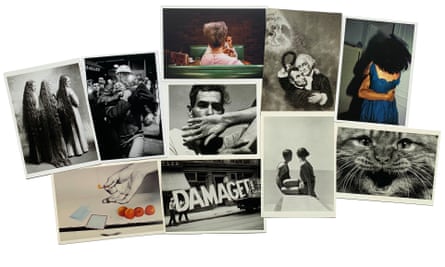
In 1975, Fotofolio was launched in New York by Martin Bondell and Juliette Galant. Bondell was a writer for TV and Galant worked at Magnum Photos before they started their joint venture – producing fine art and photographic postcards to be sold at museums and bookshops around the world. The quality reproduction they demanded, and Galant’s great relationships with the photographers and artists she worked with, means that the Fotofolio archive holds more than 10,000 different postcards including works by Man Ray, Philip-Lorca diCorcia, Nan Goldin and Robert Mapplethorpe.
The agency is now run by the couple’s daughter, Anya Bondell. “We grew up in a loft in SoHo which had also been the office of the company in its first few years,” she remembers. “My brother and I like to joke that Fotofolio was my parents’ first born, our older sibling. It was very much a part of our home life because my parents worked so hard on it together. There was no separation between their work and home, I remember images for cards being taped to the walls for review and trying on the latest artist T-shirt designs with my brother.”
During lockdown, Anya Bondell launched Fotofolio’s subscription service. You can now receive a curated package of 10 postcards from the vast archive each month by acclaimed artists but also anonymous contributors.
“Fotofolio has always sold to bookstores and gift shops but never directly to consumers,” says Anya. “We’d received requests through Instagram for certain cards, but it wasn’t until the pandemic hit and the majority of our usual customers closed, severely affecting our business, that we decided to create the online shop. The idea for subscriptions seemed like something people would enjoy, much like a monthly magazine.”
In America, the subscription is particularly prescient, as the US Postal Service is a vital part of the upcoming election’s battleground. “There have been numerous campaigns to send postcards to encourage voter turnout and enjoin participation in the election and efforts to rally around the USPS which is under attack by the current administration.”
The vast Fotofolio archive also gives you a chance to own a bit of history – or post it on to your friends. As Anya says: “In this digital age, I think there’s a beautiful tactility and intimacy to postcards.”
Fotofolio subscription from $10 a month
Clearing the air with futuristic posters
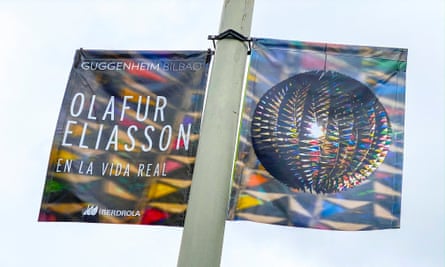
Most agree that art is good for the mind, but a new museum initiative in Spain ensures it’s good for the planet, too. Adverts for the Guggenheim Bilbao’s upcoming art shows are coated in a chemical film which turns the billboards and posters into air purifiers. The chemicals on the ads react with sunlight turning oxygen and water vapour in the air into cleaning agents, combating pollutants such as the byproducts of burning fossil fuels, bacteria and mold. Juan Ignacio Vidarte, director general of the museum, says: “This was a great opportunity to further the museum’s commitment to stop climate change.” The current ads on Bilbao’s streets for Olafur Eliasson’s show have the potential to match the environmental work of 700 trees.
A well designed home from home
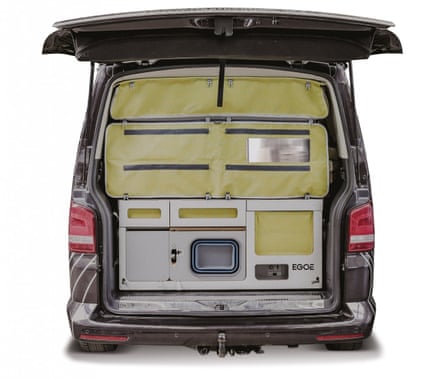
Anyone who tried out camping for the first time this summer will have discovered that equipment is key to making an outdoors staycation a holiday rather than an endurance test. If your nights under the stars were less than idyllic, maybe you should invest in the Nestbox from Czech company Egoé. This module comes in four different sizes which can fit into your car boot or into the back of a van. It folds out into a double bed and fully fitted kitchen. You can customise it with a cooker, fridge, shower attachment and, yes, even the kitchen sink.
“Global travel restrictions have caused people to rethink their vacations,” says Richard Vodička, head of Studio 519 which designed the compact camping equipment for Egoé. “Nestbox gives its users a sense of privacy, security and most importantly freedom.”
Nestbox – which was shortlisted for the Dezeen Award for Product 2020 this week – is designed and made in the Czech village Bílovice from locally sourced materials (except for the folding sink). So the only miles racked by the product are travelled by you on your adventures.
